#ueno toshogu
Explore tagged Tumblr posts
Text
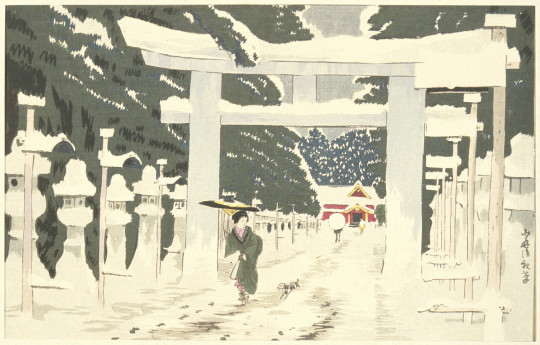
"Heavy Snow at Tōshōgū Shrine in Ueno" (上野東照宮積雪之図) by Kobayashi Kiyochika (小林清親), 1879
"Nieve intensa en el santuario Tōshōgū en Ueno" (上野東照宮積雪之図) de Kobayashi Kiyochika (小林清親), 1879
#japanese art#arte japonés#japanese prints#impresiones japonesas#小林清親#kobayashi kiyochika#東京都#東京#tokyo#tokio#上野公園#ueno koen#ueno park#上野東照宮#ueno toshogu#東照宮#toshogu#snow landscape#paisaje nevado
35 notes
·
View notes
Text

Aster Ueno Toshogu Autumn Dahlia Garden Ueno, Tokyo, Japan
#photographers on tumblr#nature#flowers#purple#autumn#fall#floral#asteraceae#asters#flores#otoño#ueno#tokyo#japan#vertical#aster#original photographers#ueno toshogu autumn dahlia garden#original photography
821 notes
·
View notes
Photo
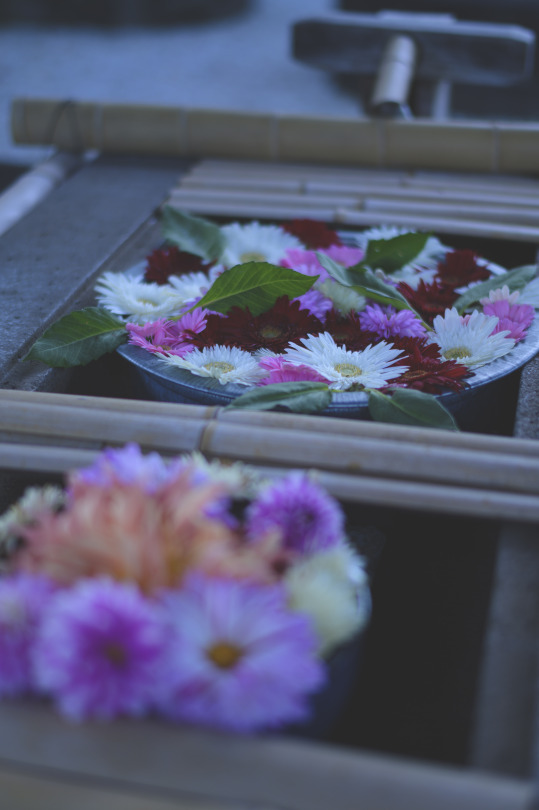
Ueno Toshogu, Ueno, Tokyo, November 2022
1 note
·
View note
Text

Karamon Ueno Toshogu Shrine, Tokyo, Japan, August 17, 2024
3 notes
·
View notes
Text
Dahlia in the Ueno Toshogu Peony Garden
1 note
·
View note
Text
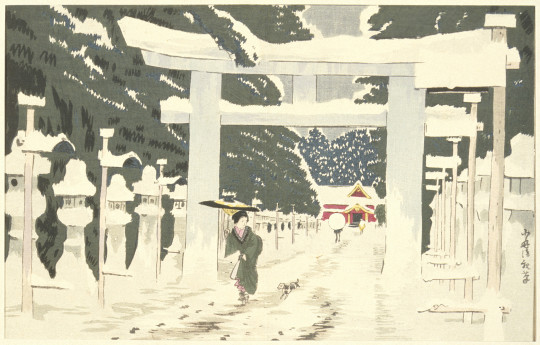
Kiyochika Kobayashi from Illustrations of famous places in Tokyo "Ueno Toshogu Shrine, snow covered." 1879
小林清親 東京名所図 「上野東照宮積雪之図」
26 notes
·
View notes
Text




上野東照宮の牡丹園はダリア祭りだった。
The peony garden at Ueno Toshogu Shrine was a dahlia festival.
2 notes
·
View notes
Text
but the entire day was pretty good, apart from ushiromiya mansion and weeboo hell i also went to ueno toshogu shrine and to national museum, it was amazing
3 notes
·
View notes
Text
May 14 - Ueno Park
Today we went to Ueno Park! This park is known for its scenic views and scale. It is so big that within it there are several shrines and temples. The first of which we visited was Shinobazunoike Bentendo. After making an offering, there were omikuji and various other trinkets that were available for purchase. I, instead, decided to buy a goshuin stamp, which I thought had nice calligraphy compared to some of the other temples I had seen. At this point, my collection of goshuin has grown to four!
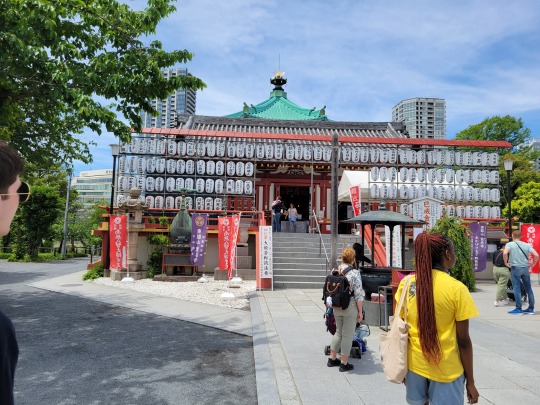
The second we visited was Ueno Toshogu Shrine. I was informed that this shrine was built in honor of Tokugawa Ieyasu as a branch of his more famous shrine. It was thought that his soul would live through this shrine and offer protection to the city of Edo in his afterlife. Contrary to most other shrines, Ueno Toshogu Shrine does not follow the Japanese visual aesthetic of wabi-sabi. Rather, it is lavishly decorated to display Tokugawa's wealth and power.
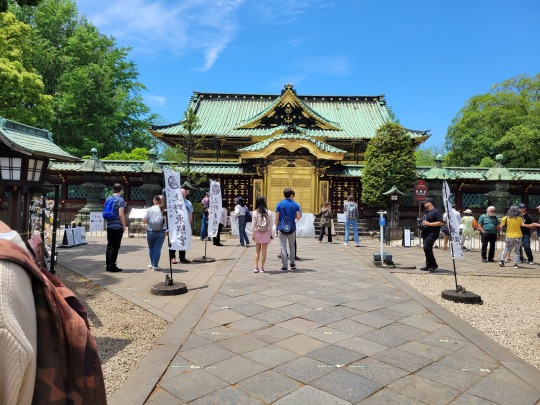
When we were done walking around Ueno Park, we visited the Tokyo National Museum. This museum had a multitude of interesting artifacts from ancient Japan. As for the building itself, it was impressive in its own right, standing out from what is expected of Japanese architecture. I will further discuss my experience in this museum in the academic discussion.
By the time we had finished exploring the museum, I was starving. For lunch, we stopped in Ameyokocho, an open-air shopping district by Ueno Station. Almost immediately, we found a butsudon restaurant. When we sat down we noticed that there was a numbness scale. Confused, we asked the server what this was, and he explained that it was different than traditional spiciness and recommended we start with only a little. The food was delicious! However, I did notice that it left a little bit of a tingling sensation on my tongue. I suppose this is what he meant by the numbness factor.
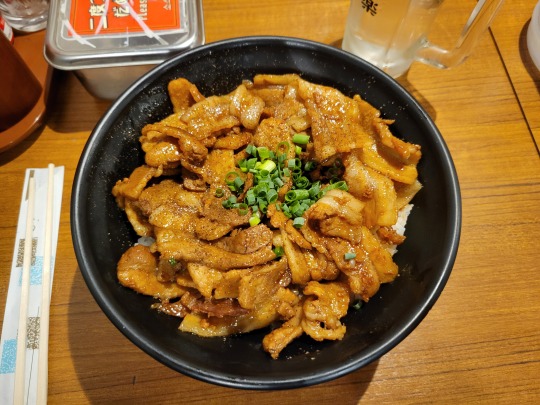
We ended the day by going to Akihabara. While I have already visited Akihabara multiple times due to its proximity to the hotel, I still had fun. I went inside one of the many arcades and played a bit of MaiMai, a Japanese arcade game, before leaving.
Academic Reflection
First, I would like to discuss my experience at the Tokyo National Museum. An artifact that immediately caught my attention was a replica of a samurai general's helmet from the late 1500s and early 1600s. This helmet unlike many others was designed to resemble a man's head. I found this fascinating as I typically associated samurai helmets as being these eye-catching spectacles as presented in Western media. However, this one had horse hair on top to resemble human hair and a headband made of black lacquer and silver leaf!
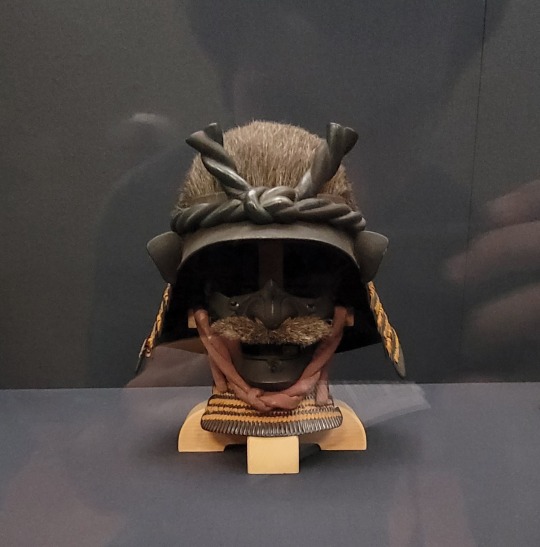
The readings for today's excursion were centered around the otaku. Defining otaku is a difficult task and, for this reason, remains to be the main topic of both readings. Azuma describes otaku through his idea of the database as opposed to the traditional grand narrative that can be found in media. If media of the modern age can be described as a fragment of a grand narrative, media of the post-modern age can be described as a database of moe around which characters are built around. Moe describes characteristics that invoke an emotion in their audience. One common example of this in anime is girls with cat-like ears. Rather than stories being written by an author and characters being placed within them, the media of the post-modern age begins with the characters. Works such as anime, manga, and other story-driven media begin, instead, with the character. The second reading further explains the psychopathology of the otaku. It explains how the otaku expresses ownership by making a work their own through parody. This, for example, includes fan art, fanfiction, and cosplay.
The influence of otaku culture is immediately apparent upon entering Akihabara. Characters with various moe elements can be seen on nearly every building as you walk through the city. Furthermore, stores such as Melonbooks sell doujinshi that are a testament to the scale of post-modern nonnarrative works. If you would like to examine otaku culture or even take part in it yourself, Akihabara is definitely the place to be.
2 notes
·
View notes
Text
May 14 — Ueno and Akihabara
Today, our day started an hour later than normal which was really nice. I haven’t slept in (until 8:30) in a while! I called my mom and dad to update them on my travels and show my brother the birthday gifts (souvenirs) I’ve gotten for him throughout my trip.
After our class meeting at 10 AM, we walked through Ueno Park to Shinobazu-no-Ike Bentendo and then Ueno Toshogu Shrine. We passed by a couple of vendors selling antique things on the way. I got a new fortune at the first shrine, and it was a very good fortune this time! Yay! At Ueno Toshogu Shrine, I got a stamp to put in my new stamp book I got yesterday.




Next, we went to the Tokyo National Museum. They had many different exhibits on each of their three floors. After walking around for about an hour, our group went to Ameyayokocho for lunch. Two of my friends and I ate Korean food. I had tteokbokki and bulgogi, both of which were really tasty, but a little bit pricy.





Our next stop was Akihabara, which is a hub of electronics, manga, and anime. There, our group broke for the day. My friends and I went to a maid cafe, which was something I’ve seen in a movie before (the One Direction This is Us movie) but never in real life. We got cute drinks and desserts! We then met up with a larger group of people in our class and went to Shibuya to browse some stores. We ended up in an area that had a ton of vintage/thrift places and used jewelry stores as well as stores that are well-known in America like Aape, Carhartt, Chrome Hearts, Lacoste, Ralph Lauren, and more. I didn’t end up buying anything here; surprising, right?


Next, we attempted to go to a conveyor belt sushi restaurant, but the wait was almost an hour long. I’m hoping that we will be able to find a conveyor belt sushi place before we leave Tokyo! Instead, we ended up eating at Ichiran Ramen, which was just as good as the last time I had it. Currently, we are on our back to the hotel. Now to see what the rest of the night has in store!!

Academic Reflection:
A piece at the Tokyo National Museum that stood out to me was a gift cover, or fukusa, with three mice and a radish. Its title was “Three Symbols of Good Fortune”, and it originates from the Edo period, 18th-19th century. It was made of silk satin, with the symbols embroidered. I learned that fukusa designs were used to transmit messages from the giver to the receiver, so often the satin material would be decorated with embellishments depicting kindness, luck, and other positive sentiments. At first, I was confused about why a radish would be a sign of good luck in Japan, but I learned that radish leaves are one of the nanakusa, the seven herbs that are traditionally eaten in January to wish for health for the rest of the year. I was mainly attracted to this art piece for its color and for its seemed use of the lucky number 3. However, I ended up learning about two different Japanese traditions through it.

In one of the readings for today, I learned about how there has been a transition away from characters rooted in narrative stories and towards a database of individual characters. I think I saw the effects of this in Akihabara, where there were countless stores devoted to prize games to win plushies or keychains of popular characters. There are many stores that sell manga, anime CDs, and other physical media, but they are often on the basement floors of buildings, while the capsule toy stores and prize game stores are on the ground level of main streets.
1 note
·
View note
Text
May 14 - Ueno Park | Akihabara


Started off with a beautiful day today! We walked through Ueno Park, and the weather was perfect for it. I took some really nice pictures of the ponds that we passed. We walked by a few small vendors and a playground. We also visited two places of worship. The first was a temple that had rows of white lanterns in front of it. There were food stands near it, which reminded me of the ones near Sensoji Temple in Asakusa. The second was the Ueno Toshogu Shrine. It’s kind of hidden somewhere in the park to be honest. It’s located near a five-storied pagoda. The shrine sold charms with coolest designs I’ve seen so far.
Afterwards, we headed to Tokyo National Museum. There were three buildings, and in the middle of all of them, there was a fountain but it looked more like a little pond. The main building that we roamed was huge! Sadia, Skylar and I started on the top floor and went through the exhibits in reverse. Then, we did the same thing on the bottom floor. We saw all kinds of art from drawings to statues to ceramics to metals to clothing items. There was just so much to see. Before looking around, Dr. Smith told us to write about an item that interested us, so I chose this beautiful light blue kimono with detailed embroidery. It was actually part of a collection of three kimonos, so Skylar, Sadia, and I each picked one and we pretended that we were Alvin and the Chipmunks. I chose the blue one, Skylar chose the green one, and Sadia chose the orange one. The description for my kimono said that there are four items hidden within the decoration that represent cultural refinement.
For lunch, we went to Ameyayokocho, which was a busy market street that offered a lot of food options. However, Sadia, Skylar, and I went to get Filipino food nearby instead. The first Filipino place seemed like it was someone’s house, but it was all you can eat for like 1,000 yen. Sadia couldn’t eat any of the food that they had, so she went to the other Filipino restaurant that we passed by. I went to check on how she was doing and ended up waiting with her. Then, we went back to the first place and ate together, even though Skylar finished her food already.
The class regrouped and then we went to Akihabara. We walked around before Dr. Smith left us to ourselves. Because Akihabara isn’t very far from the hotel, most of us have been to the area before. However, my friends and I checked out Animate for a bit. I got two books and a poster before Sadia, Joey, and I left for Nakano Broadway. Here, we bought some cheap yukatas that were still really pretty, ate dinner, and went home.
1 note
·
View note
Text

Beautyberry (Callicarpa) Ueno Toshogu Autumn Dahlia Garden Ueno, Tokyo, Japan
#photographers on tumblr#nature#purple#autumn#tokyo#japan#flora#berries#beautyberry#callicarpa#fall#ueno#ueno toshogu autumn dahlia garden#original photographers#original photography#vertical
405 notes
·
View notes
Photo

Ueno Toshogu, Ueno, Tokyo, November 2022
#snapshot#Tokyo#Ueno#Ueno Toshogu#architecture#stone#lantern#toro#temple#monochrome#NikonZ6#東京#上野#上野東照宮
1 note
·
View note
Text
Planning a 12-day winter trip to Japan sounds amazing! January is indeed a good time to visit Japan, especially if you enjoy winter activities and fewer crowds at major tourist spots. Here's a suggested itinerary to help you make the most of your trip:
### Day 1-3: Tokyo
**Day 1: Arrival in Tokyo**
- Arrive in Tokyo and check into your hotel.
- Explore Asakusa and visit Senso-ji Temple.
- Stroll through Nakamise Shopping Street.
- Enjoy dinner in the vibrant district of Shibuya or Shinjuku.
**Day 2: Tokyo Sightseeing**
- Visit the Meiji Shrine and Harajuku.
- Explore Omotesando and Takeshita Street.
- Visit the Tokyo National Museum in Ueno Park.
- Enjoy the evening in Akihabara, known for its electronics and anime culture.
**Day 3: Day Trip to Nikko or Yokohama**
- **Nikko**: Explore the UNESCO World Heritage sites like Toshogu Shrine and enjoy the winter scenery.
- **Yokohama**: Visit the Cup Noodles Museum, Minato Mirai, and Chinatown.
### Day 4-6: Kyoto
**Day 4: Travel to Kyoto**
- Take the Shinkansen (bullet train) to Kyoto.
- Check into your accommodation.
- Visit Fushimi Inari Shrine in the late afternoon/evening for a less crowded experience.
**Day 5: Kyoto Highlights**
- Visit Kinkaku-ji (Golden Pavilion).
- Explore Ryoan-ji and its famous rock garden.
- Visit Arashiyama: Bamboo Grove, Tenryu-ji Temple, and Togetsukyo Bridge.
- Optionally, take the Sagano Scenic Railway for beautiful winter landscapes.
**Day 6: Eastern Kyoto**
- Visit Ginkaku-ji (Silver Pavilion).
- Walk the Philosopher's Path.
- Visit Nanzen-ji and Eikan-do Temples.
- Explore the Gion district in the evening.
### Day 7-8: Osaka
**Day 7: Travel to Osaka**
- Take a short train ride to Osaka.
- Visit Osaka Castle and its park.
- Explore the Umeda Sky Building for great city views.
- Enjoy street food in Dotonbori.
**Day 8: Osaka and Day Trip to Nara**
- Spend the morning exploring Nara: Todai-ji Temple, Nara Park (meet the deer), and Kasuga Taisha Shrine.
- Return to Osaka and explore the Kuromon Ichiba Market.
- Enjoy an evening in Shinsekai and try Kushikatsu (deep-fried skewers).
### Day 9-10: Kanazawa
**Day 9: Travel to Kanazawa**
- Take the train to Kanazawa.
- Visit Kenrokuen Garden, one of Japan's most beautiful gardens.
- Explore Kanazawa Castle.
- Visit the 21st Century Museum of Contemporary Art.
**Day 10: Kanazawa and Onsen Experience**
- Explore Higashi Chaya District, famous for its traditional teahouses.
- Visit Myoryuji Temple (Ninja Temple).
- In the evening, travel to an onsen town like Kaga Onsen or stay at a ryokan with onsen facilities.
### Day 11-12: Return to Tokyo
**Day 11: Return to Tokyo**
- Travel back to Tokyo.
- Spend the afternoon shopping in Ginza or exploring Odaiba.
- Optional visit to Tokyo Disneyland or DisneySea if you're interested.
**Day 12: Last Minute Exploration and Departure**
- Visit any missed attractions or neighborhoods in Tokyo.
- Depending on your flight time, consider a morning visit to Tsukiji Outer Market for fresh sushi.
- Head to the airport for your departure.
### Additional Tips
- **Onsen Experience**: Consider visiting an onsen town like Hakone or Kusatsu for an authentic hot spring experience.
- **Local Food Experiences**: Take a cooking class in Kyoto or Osaka. Don’t miss trying ramen, sushi, tempura, okonomiyaki (Osaka), and kaiseki (Kyoto).
- **Winter Festivals**: Check if there are any local winter festivals or illuminations during your visit.
Enjoy your winter wonderland adventure in Japan!
Your itinerary sounds fantastic! Here's a detailed look at both options to help you decide how to spend your extra days.
### Option 1: Exploring More of Mainland Japan
**Suggestions for the Remaining 3 Days:**
1. **Kanazawa**:
- **Kenroku-en Garden**: One of Japan's top three gardens.
- **Kanazawa Castle**: Beautiful and historic.
- **21st Century Museum of Contemporary Art**: Interesting modern art exhibitions.
2. **Takayama**:
- **Old Town (Sanmachi Suji)**: Well-preserved Edo period streets.
- **Hida Folk Village**: Open-air museum showcasing traditional Japanese architecture.
3. **Himeji**:
- **Himeji Castle**: Japan’s most spectacular castle.
- You can do a day trip from Kyoto or Osaka to Himeji.
4. **Koya-san (Mount Koya)**:
- **Stay in a Buddhist temple**: Experience shukubo (temple lodging).
- **Okunoin Cemetery**: A serene and mystical place.
### Option 2: Beach Relaxation in Okinawa
**Pros of Visiting Okinawa:**
- **Beautiful Beaches**: Okinawa is known for its stunning beaches and crystal-clear waters.
- **Unique Culture**: Different from the rest of Japan, with distinct Ryukyu culture.
- **Activities**: Snorkeling, diving, and exploring the islands.
**Cons:**
- **Travel Time**: You need to account for the travel time to and from Okinawa.
- **Cost**: Additional flight costs and possibly higher accommodation costs.
### Detailed Itinerary Suggestions
**If You Stay in Mainland Japan:**
1. **Day 1-5**: Tokyo
2. **Day 6**: Day trip to Mount Fuji
3. **Day 7-11**: Kyoto
4. **Day 12**: Day trip to Himeji or Nara
5. **Day 13**: Day trip to Kanazawa or Takayama
6. **Day 14-18**: Osaka with a day trip to Hiroshima
**If You Opt for Okinawa:**
1. **Day 1-5**: Tokyo
2. **Day 6**: Day trip to Mount Fuji
3. **Day 7-10**: Kyoto
4. **Day 11-13**: Okinawa
5. **Day 14-18**: Osaka with a
day trip to Hiroshima or Nara.
### Summary
- **Staying in Mainland Japan** allows you to experience a greater variety of Japanese history, culture, and nature without the added travel time and expense of flying to Okinawa. Places like Kanazawa, Takayama, or Koya-san offer unique experiences that complement your existing itinerary.
- **Adding a Beach Break in Okinawa** gives you the chance to relax and enjoy a different side of Japan, with beautiful beaches and a unique cultural blend. It's a great way to break up the intense sightseeing with some downtime.
Both options have their merits, and your choice will depend on whether you prefer more cultural exploration or a mix of culture and relaxation. If you prefer a blend, spending a few days in Okinawa could be a refreshing change. If you're more inclined towards deep cultural immersion, exploring additional cities on the mainland would be ideal.
0 notes
Text
I went to Tokyo the past days. Like two nights before going to Europe for a few weeks.
I went to the Toshogu Shrine in Tokyo this time. I meant to go last year - it's really close to Ueno station - but since I busted my knee on the first full day in Tokyo (lol) I couldn't go.
This year I went again and got a sticker. Mainly because I want to put it on my notebook (journal) and because it was cheap (100¥!), but I didn't expect it to be this beautiful!

0 notes
Text
5. Nap - Tokió Ueno park
Jó időben bebarangoltuk az Ueno parkot, amely egy szép zöld terület. Több múzeum található benne, több szentély és egy állatkert is pandával. Mi a zöld területeket és a szentélyeket jártuk körbe. A Toshogu shrine egy 1651-ben épült 5 tornyos pagodából és aranyozott falakkal borított főépületből áll. Tokugawa Ieyasu unokája építette. Hatalmas, 600 éves Kámfor és Ginkó fák veszik körül. A Ginko fát azért telepítették a templom mellé, mert a levelei nem éghetőek, így megvédik a templomot a tűztől.
Az Ueno park után egy teaszertartáson vettünk részt. Először egy sakura teát kaptunk, abban virágszirmok voltak. Aztán volt egy rendes erős matcha, amit a szertartásvezető csinált nekünk. Előtte is utána elmagyarázta, hogy melyik japán zöld teát hogyan termesztenek és hogyan készül. Elmagyaráta, hogy egy rendes matcha koffein tartalma felér egy espressoval, mégis jótékonyabb hatású. Betegségek megelőzésére is érdemes ezt inni. Végül egymásnak készíthettünk egy gyengébb matchát. A teák között helyi mochit és rizskekszet tálalt. Egy családi étteremben vacsoráztunk, ahol kipróbáltam a hideg soba tésztát tempurált zöldségekkel.



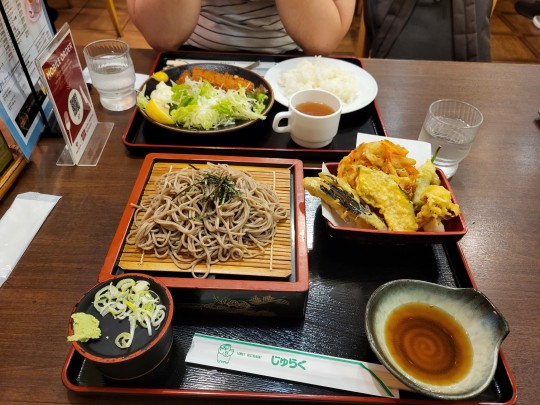
0 notes